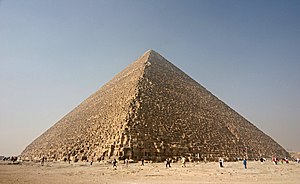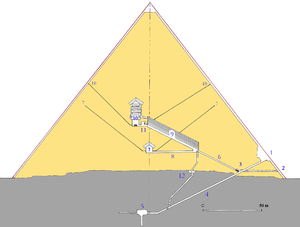|
Vikidia currently has 4,621 articles. Improve it! |
|
Join Vikidia: create your account now and improve it! |
Pyramid of Cheops
| This article was translated by Duolingo. There is an ongoing discussion about possible copyright issues. |
The Great Pyramid of Giza, also known as the Pyramid of Cheops or the Pyramid of Khufu, is the most ancient and largest of the three pyramids of the Giza Necropolis, close to what is today El Giza, in Egypt. It is the most ancient of the Seven Wonders of the Ancient World, and the only one remaining largely intact. Egyptologists consider that the pyramid was built as a tomb for the pharaoh Khufu (Cheope in Greek), 4th dynasty, over a period of 10 to 20 years, and completed around 2 560 B.C.. According to some, it was realized by the royal architect Hemiunu. Initially 146.6 metre-high, the Great Pyramid remained the tallest artificial structure in the world for over 3,800 years. At the origin, the Great Pyramid was covered with a stone coating that formed a smooth outside surface; what is seen today is the underlying base foundation. Some of the coating stones that for a time covered up the structure are still visible around the base. There have been different and alternative scientific theories about the building methods for the Great Pyramid. The most credited hypotheses about building are based on the idea that it was raised by removing from a quarry, huge blocks that, once dragged, were lifted into position.
In the interior of the Great Pyramid three rooms were discovered. The lower chamber, or underground room, is carved into the rock on which the pyramid was built and was unfinished. The Queen's and King's Chamber are higher up within the pyramid structure: the Great Pyramid of Giza is the only pyramid in Egypt known to contain both ascending and descending passages. The main part of the Giza complex is a setting of buildings that included two mortuary temples in honor of Khufu (one close to the pyramid and one near the Nile), three smaller pyramids for Khufu's wives, an even smaller pyramid "satellite "a causeway connecting the two temples, and small mastaba tombs for nobles surrounding the pyramid.
The attribution of the Great Pyramid at Cheops is deductible by the concordance of archaeological surveys and historical data available. Herodotus (fifth century B.C.), the first scholar whose writings on the pyramid have come down to us, gathered information from his contemporary Egyptian priests and integrated it in his Stories. For the following 1200 years the monument was examined mostly for the purpose of penetrating it and eventually plundering it. The Caliph To Mamun succeeded in 820 A.D. in digging a tunnel, but found the pyramid already empty. Once broken into interest in it is lost and at the end of the fourteenth century was substantially transformed into a quarry. From the mid-eighteenth century it became a destination for Western explorers in search of excitement. Only after the Napoleonic Wars (1799-1801) and the outbreak of the European Egyptomania began the systematic campaigns of study by archaeologists in Europe. With Egypt's independence, the control of the site passed into the hands of the State, which understandably permits excavation and study.
Inside, they neither coffin nor funerary equipment; this is not surprising, because almost all of the ancient Egyptian royal tombs were plundered by tomb raiders in ancient times, however, this fact, combined with the lack of decorations or hieroglyphics in the interior compartments, has spawned a number of theories not given credence to by the scientific or archaeological community due to the fact that the pyramids would not be true graves.
The access to the pyramids is limited to a maximum of 100 people in the morning and in the afternoon, and it is forbidden to take pictures inside.

